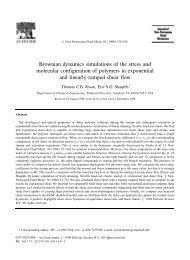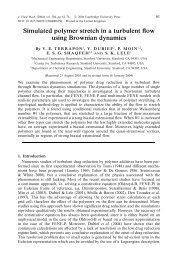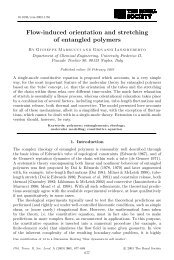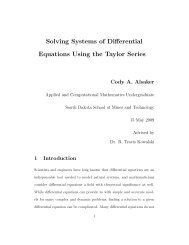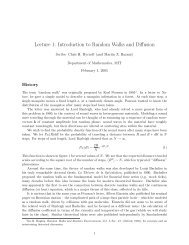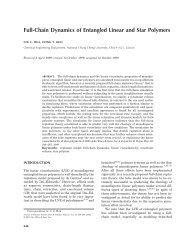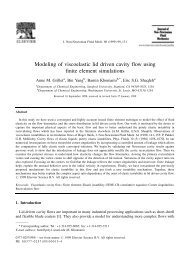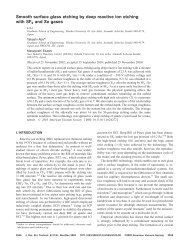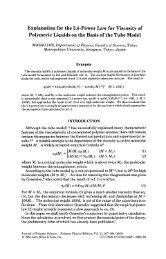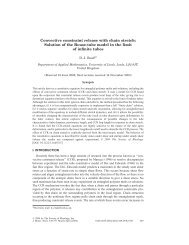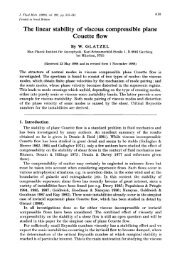A numerical study of the rheological properties of suspensions of ...
A numerical study of the rheological properties of suspensions of ...
A numerical study of the rheological properties of suspensions of ...
You also want an ePaper? Increase the reach of your titles
YUMPU automatically turns print PDFs into web optimized ePapers that Google loves.
158 M. B. Mackaplow and E. S. G. Shaqfehaddition, our formulation is valid for arbitrary orientation distributions and suffersno <strong>numerical</strong> difficulties at large aspect ratios. This approach is very similar to <strong>the</strong>one used by <strong>the</strong> present authors to <strong>study</strong> heat and mass transport in fibre <strong>suspensions</strong>(Mackaplow, Shaqfeh & Schiek 1994). In $3 we discuss our method <strong>of</strong> solving <strong>the</strong>resulting governing equations. In $4 we briefly review <strong>the</strong> existing <strong>the</strong>ory for <strong>the</strong>rheology <strong>of</strong> <strong>suspensions</strong> <strong>of</strong> non-Brownian fibres in a Newtonian fluid.In $5, we consider both aligned and isotropic fibre <strong>suspensions</strong> <strong>of</strong> concentrations0.01 < n13 < 15 in a uniaxial extensional flow. We find good agreement with <strong>the</strong>dilute <strong>the</strong>ory for n13 < 1. Beyond <strong>the</strong> dilute regime, fibre-fibre interactions enhance<strong>the</strong> average particle stresslet significantly. Our results are consistent with <strong>the</strong> screeninglength <strong>of</strong> <strong>the</strong> suspension changing from depending on <strong>the</strong> fibre length in <strong>the</strong> diluteregime to on <strong>the</strong> average interfibre spacing in <strong>the</strong> semi-dilute regime. This is <strong>the</strong> firstverification <strong>of</strong> this prediction <strong>of</strong> <strong>the</strong> semi-dilute <strong>the</strong>ory as presented by Shaqfeh &Fredrickson (1990). The screening length scaling was found to occur for both alignedand isotropic semi-dilute <strong>suspensions</strong>, again as predicted by Shaqfeh & Fredrickson(1990). We also directly verify suspension screening by <strong>study</strong>ing <strong>the</strong> decay <strong>of</strong> <strong>the</strong>velocity field created by individual stokeslets.Also in 95, we compare our simulations to <strong>the</strong> experimental data <strong>of</strong> Weinberger(1970), Mewis & Metzner (1974), and Pittman & Bayram (1990), for aligned distributions,and Bibbo (1987), for both isotropic and steady-state shear distributions.We found excellent agreement between <strong>the</strong> experiments and simulations and fur<strong>the</strong>rsupport for <strong>the</strong> concentration scaling <strong>of</strong> <strong>the</strong> screening noted above. Finally, in $6we provide a concluding discussion <strong>of</strong> our simulation technique and reiterate <strong>the</strong>important results. We also discuss a straightforward extension <strong>of</strong> our technique todetermine <strong>the</strong> effective mobility <strong>of</strong> fibres in a sedimenting suspension.2. Ma<strong>the</strong>matical formulation <strong>of</strong> <strong>the</strong> problemWe consider a suspension <strong>of</strong> rigid, non-Brownian particles in a Newtonian fluid.When <strong>the</strong> Reynolds number <strong>of</strong> <strong>the</strong> suspension is much less than unity, boundaryintegral methods can be used to represent <strong>the</strong> disturbance to <strong>the</strong> flow field due to<strong>the</strong> presence <strong>of</strong> <strong>the</strong> particles, vD(x), as an integral <strong>of</strong> singularities distributed over <strong>the</strong>particle surfaces (Ladyzehnskaya 1963)N r nd, denotes <strong>the</strong> surface <strong>of</strong> particle i, f(x) is <strong>the</strong> force/area <strong>the</strong> particle exerts on<strong>the</strong> fluid, and H(x) is <strong>the</strong> Oseen tensor, (l/?mp)(d/Ixl + xx/IxI3), which determines<strong>the</strong> response <strong>of</strong> a fluid to a point force. When combined with integral equationsspecifying <strong>the</strong> total net force and torque on each particle, <strong>the</strong> result is a coupled set <strong>of</strong>two-dimensional integral equations that can be solved <strong>numerical</strong>ly for <strong>the</strong> singularitydistributions on, and velocities and angular velocities <strong>of</strong>, each particle. The former arerelated to <strong>the</strong> <strong>rheological</strong> <strong>properties</strong> <strong>of</strong> <strong>the</strong> suspension. In particular, <strong>the</strong> contribution<strong>of</strong> <strong>the</strong> particles to <strong>the</strong> deviatoric stress tensor, (dP)), is(C‘P’) = --n(S)where (. . .) denotes an average over all particles in <strong>the</strong> suspension.



